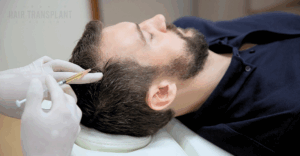Hair Cloning and Hair Multiplication – Toronto Hair Transplant Surgeons
Hair loss is a common concern for both men and women and finding effective solutions has been a longstanding goal in medical science. Over the years, researchers have explored various approaches to tackle this issue, including cloning and hair multiplication. These innovative techniques offer hope for individuals dealing with
male-pattern baldness and other forms of hair loss. In this article, we will delve into the latest developments in the field, understand the causes of hair loss, and explore the potential of cloning and hair multiplication as future treatments. Hair cloning, in particular, is transitioning from theory to practice as of 2024, marking a significant step forward in addressing hair loss.
The basic idea behind hair cloning involves extracting and multiplying healthy follicle cells or dermal papillae from non-bald scalp areas, which are then re-injected into bald regions to stimulate hair growth. This approach aims to create an endless supply of hair follicles for transplantation, offering a potentially transformative solution for individuals experiencing hair loss.
Understanding Hair Loss
Before delving into the advancements in hair cloning, it is crucial to understand the causes and mechanisms of hair loss. Male-pattern baldness, also known as androgenetic alopecia, affects a significant number of men, particularly those of Caucasian descent. Many individuals are suffering hair loss due to male-pattern baldness and other causes, making this a widespread concern. Around the age of 30, approximately one-third of white men exhibit signs of male-pattern baldness, with the prevalence increasing to around 50% by the age of 50.
Male-pattern baldness is characterized by the progressive shrinking of
hair follicles, resulting in thinner and shorter hair strands. This process is influenced by a combination of genetic factors and hormones, particularly testosterone. Researchers have identified multiple genes that contribute to the development of male-pattern baldness, suggesting that inheriting certain versions of these genes increases the likelihood of experiencing hair loss.
Cloning: The Promise of New Hair Follicles
One approach that has garnered significant attention is hair cloning. This technique involves the extraction of cells from areas of the scalp that are resistant to balding. The proposed technique includes extracting a small sample of healthy follicle cells or dermal papillae from the donor area, cloning them, and reintroducing them to regenerate hair in bald areas. These cells, known as dermal papilla cells, are then multiplied in a laboratory setting and re-injected into the scalp. The process begins with a small sample of dermal papillae or germ cells taken from the donor area, often a region with healthy donor hair. The hope is that these new cells will work in conjunction with skin cells to generate new hair follicles, ultimately leading to regrowth in balding areas. A single follicle can be used to generate a large quantity of cells, potentially producing an unlimited hair supply and new permanent hair. Hair follicle cloning and hair transplant cloning differ from traditional transplants by aiming to produce permanent hair and serve as the ultimate solution for those suffering from complete baldness. Contrary to previous beliefs, follicles are not completely absent in cases of complete baldness; existing follicles or stem cells may remain and can be used for regeneration. These techniques harness the body’s natural ability to regenerate hair, as follicles naturally arise from stem cells even in bald areas. Cell therapy is also being explored to stimulate growth and ensure the correct hair growth direction, and while the process is not as simple as cloning a sheep, it follows the same way in terms of replicating complex biological structures. However, most hair cloning research is still in the experimental phase, with ongoing studies aiming to refine these methods.
Cloning and Hair Multiplication, an Update Understanding hair loss and its causes
Dear patient, one of the most frequent questions I get asked in the office is, “Doc, how long until they can clone hair?” It seems crazy that a sheep or dog can be cloned, and yet a simple hair follicle cannot. Cloning a hair follicle requires replicating complex biological structures in the same way as cloning a sheep, which is why the process is so challenging. Below is an article on Fox News…
Scientists Fight Male-Pattern Baldness
Everybody starts out with a lifetime supply of about 100,000 follicles on the scalp, each primed to produce a single hair shaft. Normally, any given follicle pumps out that shaft for two years to six years, then takes a break for a few weeks. Then it sheds that hair, and starts the cycle over again.
Each day, we lose about 100 hairs this way. No big deal; about an equal number of follicles enter the growth phase on the same day, and at any one time about 90 percent to 95 percent of the follicles are busy growing new hair. Existing follicles have the capacity to regenerate, and research shows that follicles naturally arise from stem cells present in the scalp, even in areas affected by baldness.
But in some men, in selected places on the scalp, this orderly process goes awry.
The hair-growing phase gets progressively shorter and the resting phase gets longer. So the resulting hairs get shorter and shorter with each trip through the cycle. Eventually, they don’t even poke out through the scalp.
What’s more, affected follicles take longer to start growing hair again after they’ve shed the last one. And they shrink, so the hair they produce is finer.
In your head, it’s like replacing mighty trees with saplings. And the total number of remaining hairs slips by about 5 percent a year.
What causes this? The full picture isn’t known, but it clearly involves a combination of genetic susceptibility and hormones, including testosterone.
Researchers are eager to identify the biochemical actors within follicles that could be manipulated to fight baldness. As for genetics, some studies have implicated a particular gene that may be necessary to get the condition but not sufficient to produce baldness on its own, said Stephen Harrap of the University of Melbourne in Australia.
In all, it might take inheriting certain versions of about five genes to get the condition, like getting a bad poker hand, suggested Rodney Sinclair of the university.
The Role of Dermal Papilla Cells in Hair Cloning
Dermal papilla cells are at the heart of hair cloning technologies and play a pivotal role in the development of new hair follicles. Located at the base of each hair follicle, these specialized cells interact closely with surrounding skin cells to regulate hair growth and the formation of healthy hair follicles. In the context of hair cloning treatments, dermal papilla cells are carefully extracted from areas of the scalp where hair remains thick and healthy. These cells are then multiplied in a laboratory setting, creating a robust supply of papilla cells that can be reimplanted into the scalp.
The unique ability of dermal papilla cells to stimulate hair growth and produce new hair makes them a cornerstone of modern hair cloning research. By harnessing these cells, scientists aim to generate new hair follicles in areas affected by hair loss, offering hope for those seeking to restore a full head of healthy hair. Ongoing research is focused on refining the cultivation and transplantation process to ensure that these treatments result in strong, natural-looking new hair growth. As hair cloning technologies advance, the role of dermal papilla cells will remain central to achieving effective and lasting hair restoration.
Cell Types and Their Impact on Hair Growth
Hair growth is a complex process that relies on the coordinated activity of several different cell types within the scalp. Dermal papilla cells, as discussed, are essential for initiating and regulating the formation of new hair follicles. Alongside them, keratinocytes play a crucial role by constructing the hair shaft itself, providing the structure and strength needed for healthy hair. Stem cells, found in specific regions of the scalp, have the remarkable ability to transform into various cell types, including those that make up the hair follicle.
The interplay between these cell types—dermal papilla cells, keratinocytes, and stem cells—determines the health and vitality of each hair follicle. By understanding how these cells communicate and work together, researchers are developing innovative hair cloning treatments designed to stimulate hair growth and improve overall hair health. Manipulating these cell types to encourage the formation of new follicle cells and a robust hair shaft is a key focus in the quest to counter hair loss and restore natural hair. As research progresses, these insights will pave the way for more effective treatments that address the root causes of thinning hair.
Recent Breakthroughs in Hair Multiplication
Intercytex, a company based in England, has commenced human studies on hair multiplication. By extracting cells from the areas of the scalp resistant to balding, multiplying them thousands of times in a laboratory, and subsequently injecting them back into the scalp, Intercytex aims to stimulate the growth of new follicles. Preliminary studies involving seven men with thinning hair due to male-pattern baldness have shown promising results, with five of them experiencing hair growth.
Although the initial study was limited to a small area and did not cover bald spots, it demonstrates the potential of hair multiplication as a treatment option. With further research and development,
hair transplant surgeons may be able to cover larger areas of baldness, providing individuals with a fuller head of hair. These advancements could make it possible to effectively treat bald areas by generating new hair follicles where hair is currently absent.
Clinical Trials and Research in Hair Cloning
The field of hair cloning is rapidly evolving, with numerous clinical trials and research initiatives underway to assess the safety and effectiveness of these cutting-edge treatments. Research groups and companies are experimenting with various culturing methods to multiply hair follicle cells, including dermal papilla cells, outside the body. Once a sufficient quantity of healthy follicle cells is produced, they are reimplanted into the scalp with the goal of generating new hair growth in areas affected by hair loss.
These clinical trials are essential for determining how well hair cloning technologies can treat hair loss and for identifying any potential side effects. Scientists are also exploring which cell types and culturing methods yield the best results, aiming to optimize the process for consistent and natural-looking new hair. As these studies progress, the hope is that hair cloning treatments will become a reliable option for those seeking to restore their hair, offering new hair growth and improved hair health for individuals experiencing thinning or balding.
Non-Surgical Hair Restoration Options
While hair cloning treatments are still in the early stages of development, there are several non-surgical hair restoration options available for those looking to treat hair loss. Low-level laser therapy is a popular choice, using targeted light energy to stimulate hair follicles and encourage hair growth. Scalp micropigmentation offers a cosmetic solution by depositing pigments into the scalp, creating the appearance of fuller hair and camouflaging thinning areas.
In addition, a range of hair care products—such as minoxidil and finasteride—are widely used to stimulate hair growth and slow the progression of hair loss. These treatments can help maintain hair health and are often recommended as part of a comprehensive approach to hair restoration. For many individuals, combining non-surgical options with emerging hair cloning treatments may provide the best results, supporting both new hair growth and the preservation of existing hair follicles.
The Future of Hair Loss Treatments
Hair cloning and hair multiplication techniques have shown tremendous potential in the field of hair loss treatment. Researchers are optimistic about the possibility of developing commercial products within the next five years. The ability to regenerate hair on a bald scalp may no longer be a distant dream, but a reality that individuals can choose to pursue. With these advanced techniques, there is the potential to create an unlimited hair supply and generate new permanent hair for those affected by hair loss. The latest breakthroughs in hair cloning include successful cloning of hair follicles in animal models, indicating potential for future human applications.
Additionally, the advancements in hair follicle research extend beyond
hair loss treatments. Hair follicles are considered organs, and the knowledge gained from studying them can contribute to the development of regenerative techniques for larger organs such as the liver and kidneys. Moreover, insights into stem cells, cell growth, and gene therapy garnered from follicle research may have broader applications in the treatment of diseases like cancer and Alzheimer’s.
Considering the Costs and Future Prospects
As with any pioneering medical advancement, questions arise regarding the cost of hair cloning and its accessibility. While the treatment remains in its developmental stages, specifics about hair cloning transplant cost and widespread availability in hair cloning clinics are yet to be fully realized. However, the potential benefits and promising outcomes may offset these concerns, making it an attractive prospect for individuals seeking long-term solutions to hair loss. Hair cloning is often regarded as the ultimate solution for those seeking a permanent cure for baldness and alopecia.
Choosing the Right Hair Restoration Method
Selecting the most appropriate hair restoration method is a highly personal decision that depends on several factors, including the extent of hair loss, overall health, and individual preferences. For those experiencing significant hair loss, hair cloning represents a promising future option, though it is still in the early stages of clinical development. Hair transplants remain a well-established and effective technique, offering permanent results by relocating healthy hair follicles to thinning or balding areas. Surgical options, such as hair transplants, can provide the most comprehensive hair restoration outcomes, making them a reliable choice for individuals seeking long-term solutions.
Non-surgical treatments, such as low-level laser therapy and specialized hair care products, can be valuable for those seeking to stimulate hair growth and improve hair health without undergoing surgery. Consulting with a healthcare professional or hair restoration specialist is essential to evaluate the degree of hair loss, discuss available treatments, and develop a personalized plan. By considering all available options, individuals can make informed choices to achieve the best possible outcome for their hair restoration journey.
FAQs
What is meant by hair restoration cloning, and how does it work?
Hair restoration cloning refers to the process of using cloned cells, particularly dermal papilla cells, to restore hair growth in individuals experiencing hair loss. This technique involves replicating these cells in a controlled environment and then transplanting them to facilitate the growth of new hair follicles. Hair restoration cloning is a form of cell therapy aimed at rejuvenating or regenerating hair follicles to promote hair growth.
Are there specialized clinics that offer hair cloning procedures?
Yes, certain specialized clinics or research centers might provide experimental hair cloning procedures. These clinics often conduct trials or research studies related to hair cloning for individuals experiencing hair loss.
What are the expected results from a hair cloning procedure?
The anticipated outcomes from a hair cloning procedure can vary, but generally, it involves the potential growth of new hairs in previously bald or thinning areas. Early trials have shown promising results, with significant hair regrowth observed in treated individuals. The goal of hair cloning procedures is to produce healthy hair by generating new, functional hair follicles.
What factors determine the hair cloning cost and hair cloning transplant cost?
The costs associated with hair cloning and hair cloning transplant procedures can vary based on several factors. These may include the clinic or research institution conducting the procedure, the complexity of the treatment, the technology employed for cell multiplication and transplantation, as well as the extent of the balding area to be treated.
How does hair cloning for transplant differ from traditional hair transplants?
A hair cloning transplant aims to generate entirely new hair follicles by multiplying extracted cells. In contrast, traditional hair transplants involve relocating existing hair follicles from one part of the scalp to another. These traditional methods depend on a limited donor area and the availability of donor hair, which can restrict the number of follicles that can be transplanted. Hair cloning techniques could eliminate this limitation by enabling unlimited hair growth regardless of donor hair availability.
What are the anticipated hair cloning results for bald individuals?
Anticipated results from hair cloning for transplant or treatment involve new hair growth in balding areas. Even in cases of complete baldness, hair follicles are not completely absent; some stem cells or residual follicle structures often remain and can potentially be used for regeneration.
Preliminary studies have shown promising outcomes, with significant hair growth observed in individuals who underwent experimental procedures involving cloned cells.
While the complete cloning of human hair follicles remains a challenge, the progress made in hair multiplication offers hope to individuals struggling with hair loss. Techniques involving the multiplication of existing cells show promise in generating new follicles and increasing hair growth. As research continues, the development of effective hair loss treatments may soon become a reality. By understanding the causes of hair loss and exploring innovative solutions, individuals can make informed decisions about their hair restoration journey.





